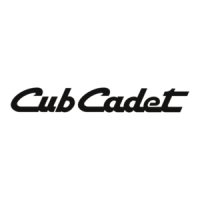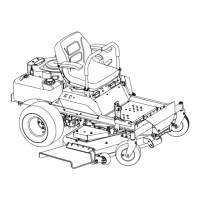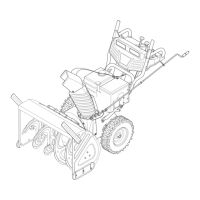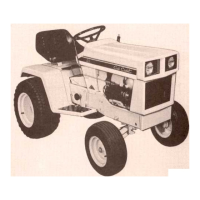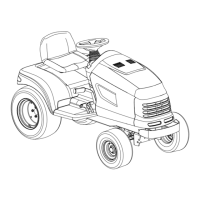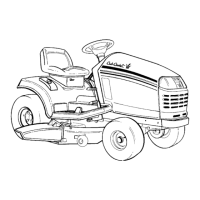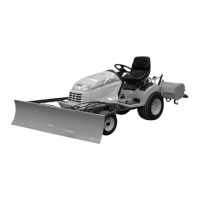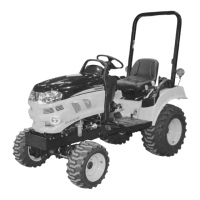4
SAFE OPERATION PRACTICES
CHILDREN
1. Tragic accidents can occur if the operator is not alert to the presence of children.
Children are often attracted to the machine and the mowing activity. They do not
understand the dangers. Never assume that children will remain where you last
saw them.
a. Keep children out of the mowing area and in watchful care of a responsible
adult other than the operator.
b. Be alert and turn machine off if a child enters the area.
c. Always look behind and down for small children. Use slow speed.
d. Never carry children, even with the blade(s) shut off. They may fall off or
interfere with safe mower operation, causing serious injury or death.
e. Use extreme care when approaching blind corners, doorways, shrubs, trees, or
other objects that may block your vision of a child who may run into the path
of the machine.
f. To avoid back-over accidents, always disengage blades before traveling
in reverse.
g. Keep children away from hot or running engines. They can suffer burns from a
hot muffler.
h. Remove key when machine is unattended to prevent unauthorized operation.
2. Never allow children under 16 years of age to operate this machine. Children
16 and over should read and understand the instructions and safe operation
practices in this manual and on the machine and should be trained and supervised
by an adult.
TOWING
1. Do not tow heavy tow-behind attachments (e.g. loaded dump cart, lawn roller,
etc.) on slopes greater than 5° (9%).
2. Tow only with a machine that has a hitch designed for towing. Do not attach
towed equipment except at the hitch point.
3. Follow the manufacturer’s recommendation for weight limits for towed
equipment and towing on slopes.
4. Never allow children or others in or on towed equipment.
5. On slopes, the weight of the towed equipment may cause loss of traction and loss
of control.
6. Travel slowly and allow extra distance to stop.
7. Make wide turns to avoid jack knifing.
TRANSPORTING
1. This machine is not intended for use on public roads. Machines operated on public
roads must comply with state and local ordinances, SAE J137, and ANSI/ASABE
S279 (lighting and marking requirements).
2. Use care when loading or unloading machines onto trailers and trucks.
3. If ramps are used, they must be full width, stable, have an adequate capacity
rating, and be secured to the trailer or truck. Ramp angle should not exceed 25°
(46%) and trailer or truck should be parked on level terrain.
4. Machines must be secured onto trailers and trucks with straps, chains, cables,
ropes, or other means deemed adequate for that purpose. The front and rear
of the machines must be secured to the trailer or truck in both the lateral and
vertical directions.
OPERATOR PROTECTIVE SYSTEM OPS
1. This machine is equipped with an Operator Protective System (OPS),
which includes:
a. A Roll Over Protective Structure (ROPS) of the fixed or folding configuration.
b. Seat belt assembly with retractable function.
2. ROPS are structures designed to provide a crush-resistant space for the operator
when properly seat-belted within the designated seating area of the machine in
the event of a machine tip-over or roll-over. Folding ROPS shall be used in their
fully upright and locked configurations except in those circumstances whereby
they need to be momentarily folded-down to avoid contact with items such as
tree limbs, clothes lines, guy wires, utility poles, buildings, etc. At other times and
conditions, ROPS shall be in their fully upright and locked configurations.
DANGER
Damaged ROPS must be replaced prior to operator use.
3. Seat belts shall be used and shall be properly fastened about the operator’s waist
at all times, except when the ROPS are:
a. Not properly installed and/or not properly secured onto the machine.
b. Damaged in such manner that their structural integrity has been compromised.
c. Not in their fully upright and locked position.
4. Seat belts are attached to the movable portion of the seat when suspension seats
are utilized, and therefore the seat-mounting base must be secured to its pivot
means and the pivot means latched to the frame of the machine. Seat belts are
attached to the seat or the frame of the machine when non-suspension (standard)
seats are provided, however, if a suspension kit is added to a seat, the seat belt
must be attached to the movable portion of the seat or suspension mechanism,
the seat-mounting base must be secured to its pivot means, and the pivot means
be latched to the frame of the machine.
DANGER
If ROPS are folded down or missing, seat belts shall not be fastened. Worn or
damaged seat belt assemblies must be replaced prior to operator use.
5. A brush guard or canopy may deflect tree limbs, clothes lines, and other obstacles
that otherwise could come in contact with the ROPS. Contact of ROPS, brush
guard, and/or canopies by items such as tree limbs, clothes lines, guy wires,
and buildings, could create hazardous conditions whereby the machine could
experience a tip-over or roll-over. A canopy may provide protection for the
operator from some environmental exposure (sunlight, rain, etc.).
6. The ROPS and seat belt are integral parts of this machine and should not be
tampered with, modified in any manner, or removed.
7. Inspect the ROPS and seat belt assemblies on a regular basis for damage and
improper operation. Replace all components that are damaged or are not
functioning properly with authorized replacement parts.
8. The ROPS extends above and behind the operator position, and therefore the
operator must be aware of potential contact of the ROPS with items such as trees,
buildings, doorways, clothes lines, utility wires, etc., that could cause the machine
to tip-over or rollover. Use caution in (or avoid) areas where the ROPS could come
in contact with any structures, trees, etc.
9. Inspect the ROPS and seat belt assemblies on a regular basis for damage and
improper operation. Replace all components that are damaged or are not
functioning properly with authorized replacement parts.
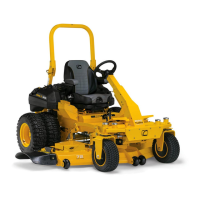
